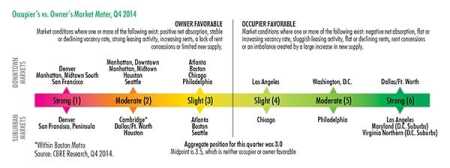Owners of office space are continuing to gain leverage as steady economic growth has pushed office occupancy to all-time highs across the United States, according to a new report from CBRE Research. The report finds that annual tenant demand, as measured by net absorption, totaled 52.7 million square feet (4.9 million sq m) in 2014—the highest annual amount since 2007. This demand has pushed up the number of U.S. downtown and suburban markets on CBRE’s quarterly “Occupiers vs. Owners Market Meter” to 19 owner-favorable markets, compared with just eight occupier-favorable markets.
Downtown markets across the country saw the strongest annual total since 2006, with 21.1 million square feet (2 million sq m) of positive net absorption. Manhattan (7.3 million sq ft [678,000 sq m]), Houston (5.5 million sq ft [511,000 sq m]), and San Jose (3.9 million sq ft [362,000 sq m]) represented the top markets for net absorption, followed by Dallas/Fort Worth, Atlanta, and Orange County, with 2.5 million square feet (232,000 sq m) each.
Demand continues to be fueled primarily by the high-tech sector, which accounted for 19 percent of 2014’s largest lease transactions by square footage across the country. This represents a significant jump over the year prior, where high tech accounted for 13.6 percent of the largest lease transactions. Financial services, business services, health care/life sciences, and creative services rounded out the top five sectors for leasing activity in major markets in 2014.
“The short-term outlook is for high tech, financial services, and government to be the most active industries leasing office space,” says Colin Yasukochi, director of research and analysis for CBRE. “As supply is slow to respond to this growing demand, tenants can expect to see rising occupancy costs, which will compel many to consider ways to achieve more efficient footprints through workplace strategy, or to explore lower-cost submarkets.”
According to the CBRE report, U.S. economic growth is expected to further boost office space demand over the next three years, leading to tight market conditions and higher rents—ten of the 14 major downtown markets and eight of the 13 major suburban markets surveyed by CBRE Research are expecting rents to rise in 2015. Vacancy should continue its downward trend in the near term, bottoming out at 12.2 percent in 2018.



